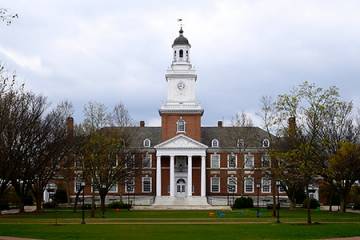To address the university community's most pressing questions and concerns about returning to campus amid the COVID-19 pandemic, two of Johns Hopkins University's 2020 Planning workgroups released a first draft of recommended universitywide health and safety guidelines Thursday that will allow the JHU community to come together in the weeks and months ahead.
The guidelines describe a gradual return, in which only those activities that must be conducted on campus will be, and others will continue to be performed remotely. The timing for this phased return to begin will depend on state and local authorities and public health guidance; the draft guidelines are intended to spark additional discussion and feedback from the university community in preparation for that day.
More than 2,400 people attended a virtual town hall on Friday to discuss the guidelines, submitting more than 150 questions about the proposed policies on masking, accommodations for vulnerable populations, transportation, parking and other issues. An archived broadcast of the town hall can be viewed online, and additional feedback can be submitted to covidtownhall@jhu.edu or shared via the JHU 2020 Planning website.
The guidelines are based on detailed recommendations and analysis from the Faculty/Staff Return to Campus workgroup, led by Heidi Conway, vice president for human resources, and Andrew Douglas, vice provost for faculty affairs; and the Facilities & Health, Safety, and Environment workgroup, led by Bob McLean, vice president for facilities and real estate.
Over the past month, both groups have engaged in intensive planning and consulted with other cross-divisional workgroups exploring issues related to returning to campus. They have considered feedback from many faculty, staff, and students who have participated in virtual town halls or submitted feedback about the planning process.
The university's multiphase plan signals that a full return by all affiliates is not expected until there is a vaccine or effective treatments for COVID-19, or if there is substantial immunity among the university community. Protecting students, faculty, and staff is the guiding principle for each recommendation made by the return-to-campus workgroup, Conway said.
"When and how we resume our in-person activities in the physical spaces that animate university life will depend on the arc of the pandemic and the best public health practices available to mitigate its impacts," she said.
According to the guidelines, activities including research, limited graduate-level instruction, and limited access to campus facilities—all with appropriate physical distancing, masking, and other public health strategies—are likely to be among the first activities to resume on campus. Most faculty and staff should expect to continue to telework indefinitely in order to keep the density of people in university buildings low.
The draft guidelines address a range of topics related to personal safety practices, use of campus facilities and new operational procedures. The recommendations include:
- Establishing plans to ensure appropriate social distance between affiliates through altered workspaces, placing occupancy limits on shared spaces, staggered schedules, and continued telework options
- Universal face-covering while on campus—indoors and outdoors—with very limited exceptions
- Guidance to protect peoples' health and safety, including monitoring symptoms, maintaining social distancing, and expanded cleaning
- Protocols for riding a shuttle, eating meals, and using the elevator
- Accommodations for people who are at higher risk for poor COVID-19 outcomes
- Providing ongoing support for mental and emotional well-being for the university community
The workgroup members emphasize that a move to start allowing some on-campus activities under the recommended guidelines does not mean a resumption of business as usual for the university, and that life on campus will feel very different than it was before the pandemic.
"The core mission of the university remains unchanged, even in a changed environment," McLean said. "We are committed to maintaining a standard of excellence safely supporting research and, as we move to future phases, supporting instructional and other activities regardless of what form they may take. We are committed to moving forward in a way that protects the safety of our affiliates."
Posted in University News








